Japan–United Kingdom relations
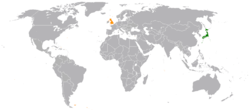 | |
Japan |
United Kingdom |
|---|---|
| Diplomatic Mission | |
| Embassy of Japan, London | British Embassy, Tokyo |
| Envoy | |
| Ambassador Keiichi Hayashi | Ambassador Paul Madden |
Japan–United Kingdom relations (日英関係 Nichieikankei) are the bilateral and diplomatic relations between Japan and the United Kingdom.
History
The history of the relationship between Japan and England began in 1600 with the arrival of William Adams (Adams the Pilot, Miura Anjin) on the shores of Kyushu at Usuki in Ōita Prefecture. During the Sakoku period (1641–1853), there were no formal relations between the two countries. The Dutch served as intermediaries. The treaty of 1854 began formal diplomatic ties which, improved to become a formal alliance 1902-1922. The British Dominions pressured Britain to end the alliance. Relations deteriorated rapidly in the 1930s, over Manchuria and China, and the cutoff of oil supplies in 1941. Japan declared war in December 1941 and seized Hong Kong, British Borneo (with its oil), and Malaya. They sank much of the British fleet and forced the surrender of Singapore, with many prisoners. They reached the outskirts of India until being pushed back. Relations improved in the 1950s and, as memories of the wartime atrocities fade, have become warm. On 3 May 2011, British Foreign Secretary William Hague said that Japan is "one of [Britain]'s closest partners in Asia".
Chronology of Japanese–British relations
- 1587. Two young Japanese men named Christopher and Cosmas sailed on a Spanish galleon to California, where their ship was seized by Thomas Cavendish. Cavendish brought the two Japanese men with him to England where they spent approximately three years before going again with him on his last expedition to the South Atlantic. They are the first known Japanese men to have set foot in the British Isles.
Early
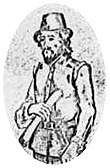
- 1600. William Adams, a seaman from Gillingham, Kent, was the first English adventurer to arrive in Japan. Acting as an advisor to the Tokugawa shōgun, he was renamed Miura Anjin, granted a house and land, and spent the rest of his life in his adopted country.
- 1605. John Davis, the famous English explorer, was killed by Japanese pirates off the coast of Thailand, thus becoming the first known Englishman to be killed by a Japanese.[1]
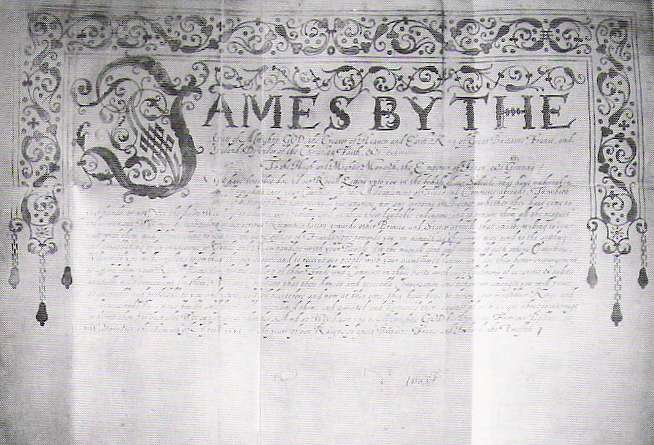
- 1613. Following an invitation from William Adams in Japan, the English captain John Saris arrived at Hirado Island in the ship Clove with the intent of establishing a trading factory. Adams and Saris travelled to Suruga Province where they met with Tokugawa Ieyasu at his principal residence in September before moving on to Edo where they met Ieyasu's son Hidetada. During that meeting, Hidetada gave Saris two varnished suits of armour for King James I, today housed in the Tower of London.[2] On their way back, they visited Tokugawa once more, who conferred trading privileges on the English through a Red Seal permit giving them "free licence to abide, buy, sell and barter" in Japan.[3] The English party headed back to Hirado Island on 9 October 1613. However, during the ten year activity of the company between 1613 and 1623, apart from the first ship (Clove in 1613), only three other English ships brought cargoes directly from London to Japan.
- 1623. The Amboyna massacre occurred. After the incident England closed its commercial base at Hirado Island, now in Nagasaki Prefecture, without notifying Japan. After this, the relationship ended for more than two centuries.
- 1639. Tokugawa Iemitsu announced his Sakoku policy. Only the Netherlands was permitted to retain limited trade rights.
- 1673. An English ship named "Returner" visited Nagasaki harbour, and asked for a renewal of trading relations. But the Edo shogunate refused. The government blamed it on the withdrawal 50 years earlier, and found it unacceptable that Charles II of England married Catherine of Braganza, who was from Portugal, and favoured the Roman Catholic Church.
- 1808. The Nagasaki Harbour Incident: HMS Phaeton enters Nagasaki to attack Dutch shipping.
- 1832. Otokichi, Kyukichi and Iwakichi, castaways from Aichi Prefecture, crossed the Pacific and were shipwrecked on the west coast of North America. The three Japanese men became famous in the Pacific Northwest and probably inspired Ranald MacDonald to go to Japan. They joined a trading ship to the UK, and later Macau. One of them, Otokichi, took British citizenship and adopted the name John Matthew Ottoson. He later made two visits to Japan as an interpreter for the Royal Navy.
1854-1900
- 1854. 14 October. The first limited Anglo-Japanese Friendship Treaty was signed by Admiral Sir James Stirling and representatives of the Tokugawa shogunate (Bakufu).
- 1855. In an effort to find the Russian fleet in the Pacific Ocean during the Crimean war, a French-British naval force reached the port of Hakodate, which was open to British ships as a result of the Friendship Treaty of 1854, and sailed further north, seizing the Russian-American Company's possessions on the island of Urup in the Kuril archipelago. The Treaty of Paris (1856) restitutes the island to Russia.[4]
- 1858. 26 August. The Anglo-Japanese Treaty of Amity and Commerce was signed by the Scot Lord Elgin and representatives of the Tokugawa shogunate for Japan, after the Harris Treaty was concluded. Britain obtained extraterritorial rights on Japanese with the British Supreme Court for China and Japan, in Shanghai. A British iron paddle schooner named Enpiroru was presented to the Tokugawa administration by Bruce as a present for the Emperor from Queen Victoria.
- 1861. 5 July. The British legation in Edo was attacked.
- 1862. The shōgun sends the First Japanese Embassy to Europe, led by Takenouchi Yasunori.
- 1862. 14 September. The Namamugi Incident occurred within a week of the arrival of Ernest Satow in Japan.
- 1862–75. British Military Garrison established at Yamate, Yokohama.
- 1863. The Chōshū Five began their education at University College London under the guidance of Professor Alexander William Williamson.
- 1863. Bombardment of Kagoshima by the Royal Navy. (Anglo-Satsuma War).
- 1864. Bombardment of Shimonoseki by Britain, France, the Netherlands and the USA.
- 1865 The Hong Kong and Shanghai Bank (HSBC) from Britain was established in Hong Kong.
- 1865. Chōshū Domain bought the warship Union from Glover and Co., an agency of Jardine Matheson established in Nagasaki, in the name of Satsuma Domain which was not against the Tokugawa shogunate then.
- 1866 HSBC established a Japanese branch in Yokohama.
- 1867. The Icarus affair, an incident involving the murder of two British sailors in Nagasaki, leading to increased diplomatic tensions between Britain and the Tokugawa shogunate.
- 1868. Coup d'état by Chōshū Domain and Satsuma Domain achieved the Meiji Restoration.
- 1869. Alfred, Duke of Edinburgh becomes the first European prince to visit Japan arriving on HMS Galatea on 4 September 1869. Audience with the Emperor Meiji in Tokyo.
- 1872. The Iwakura mission visited Britain as part of a diplomatic and investigative tour of the United States and Europe.
- 1873. The Imperial College of Engineering opened with Henry Dyer as principal.

- 1879 British Court for Japan was established in Yokohama.
- 1880 Japan government established Yokohama Specie Bank for only foreign transaction bank in Japan, with the support of HSBC.
- 1886 Normanton incident British merchant vessel sinks off the coast of Wakayama Prefecture. Crew escape while 25 Japanese passengers perish. Widespread Japanese public outrage as subsequent Board of Enquiry under extraterritorial court fails to hold British crew to account.
- 1885–87. Japanese exhibition at Knightsbridge, London.[5]
- 1887–89. Jurist Francis Taylor Piggott, the son of ex-MP Jasper Wilson Johns, was inaugurated as a legislational consultant for Itō Hirobumi, then and the first Prime Minister of Japan.
- 1890. Government of Japan established the Constitution of Imperial Japan which House of Peers was not come with Universal suffrage.
- 1891. The Japan Society of London is founded by Arthur Diosy.
- 1894. The Anglo-Japanese Treaty of Commerce and Navigation was signed in London on 16 July. The treaty was abolished extraterritoriality in Japan for British subjects with effect from 17 July 1899
- 1899 Extraterritorial rights for British subjects in Japan came to an end.
- 1900 (January) Last sitting of the British Court for Japan.
20th century
- 1902. The Japanese–British alliance was signed in London on 30 January. It was a diplomatic milestone that saw an end to Britain's splendid isolation, and removed the need for Britain to build up its navy in the Pacific.[6]
- 1905. The Japanese–British alliance was renewed and expanded. Official diplomatic relations were upgraded, with ambassadors being exchanged for the first time.
- 1907 In July, British thread company J. & P. Coats launched its subside Teikoku Seishi and began to thrive.
- 1908. The Japan-British Society was founded in order to foster cultural and social understanding.
- 1909 Fushimi Sadanaru returns to Britain to convey the thanks of the Japanese government for British advice and assistance during the Russo-Japanese War.
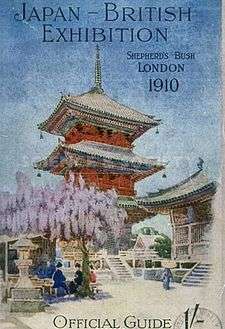
- 1910 Sadanaru represents Japan at the state funeral of Edward VII, and meets the new king George V at Buckingham Palace. The Japan–British Exhibition is held at Shepherd's Bush in London.
- 1911. The Japanese - British alliance was renewed.
- 1913. The IJN Kongō, the last of the British-built warships for Japan's navy, enters service.
- 1914-1915. Japan joined World War I as Britain's ally under the terms of the alliance and captured German-occupied Tsingtao (Qingdao) in China Mainland. They also help Australia and New Zealand capture archipelagos like the Marshall Islands and the Mariana Islands.
- 1915. The Twenty-One Demands would have given Japan varying degrees of control over all of China, and would have prohibited European powers from extending their Chinese operations any further.[7]
- 1917. The Imperial Japanese Navy helps the Royal Navy and allied navies patrol the Mediterranean against Central Powers ships.
- 1919. Japan proposes a racial equality clause in negotiations to form the League of Nations, calling for "...making no distinction, either in law or in fact, on account of their race or nationality." [8] Britain, which supports the White Australia policy, cannot assent, and the proposal is rejected.
- 1921. Crown Prince Hirohito visited Britain and other European countries. It was the first time that a Japanese crown prince had traveled overseas.
- 1921. Arrival in September of the Sempill Mission in Japan, a British technical mission for the development of Japanese Aero-naval forces.
- 1922 - Washington Naval Conference concluding in the Four-Power Treaty, Five-Power Treaty, and Nine-Power Treaty; major naval disarmament for 10 years with sharp reduction of Royal Navy & Imperial Navy. The Treaties specify that the relative naval strengths of the major powers are to be UK = 5, US = 5, Japan = 3, France = 1.75, Italy = 1.75. The powers will abide by the treaty for ten years, then begin a naval arms race.[9]
- 1922. Edward, Prince of Wales travelling on HMS Renown, arrives in Yokohama on the 12th of April for a four-week official visit to Japan.
- 1923. The Japanese -British alliance was officially discontinued on 17 August in response to U.S. and Canadian pressure.
- 1930, The London disarmament conference angers Japanese Army and Navy. Japan's navy demanded parity with the United States and Britain, but was rejected; it maintained the existing ratios and Japan was required to scrap a capital ship. Extremists assassinate Japan's prime minister and the military takes more power.[10]
- 1931, September. Japanese Army seizes control of Manchuria, which China has not controlled in decades. It sets up a puppet government. Britain and France effectively control the League of Nations, which issues the Lytton Report in 1932, saying that Japan had genuine grievances, but it acted illegally in seizing the entire province. Japan quits the League, Britain takes no action.[11][12]
- 1934. The Royal Navy sends ships to Tokyo to take part in a naval parade in honour of the late Admiral Tōgō Heihachirō, one of Japan's greatest naval heroes, the "Nelson of the East".
- 1937. The Kamikaze, a prototype of the Mitsubishi Ki-15, travels from Tokyo to London, the first Japanese-built aircraft to land in Europe, for the coronation of King George VI and Queen Elizabeth.
- 1938 Yokohama Specie Bank acquired HSBC.[13]
- 1939. The Tientsin Incident almost causes an Anglo-Japanese war when the Japanese blockade the British concession in Tientsin, China.
- 1941, December 7/8. Pacific War begins as the Japan attacks British possessions in Malaya, Singapore, and Hong Kong.
- 1942, The surrender of Singapore is a humiliating defeat for the British; over hundred thousand Imperial soldiers become prisoners. Asian nationalists celebrate the victory over the Europeans.[14]
- 1941–1945. In the first few months of war Japanese forces race from victory to victory. They capture British Borneo, Malaya, Burma, and Singapore. Many British POWs die in very harsh conditions of captivity.
- 1945, September 2. Aboard the USS Missouri in Tokyo Bay, Admiral Bruce Fraser is among the allied commanders formally accepting the surrender of Japan.
- 1945-1951, Japan is under American occupation, with only a small nominal role for the British representative.
- 1948. The 1948 Summer Olympics was held in London. Japan did not participate.
- 1951. Treaty of San Francisco – the peace treaty in which Anglo-Japanese relations were normalized. One condition of the treaty was Japan's acceptance of the judgements of the Tokyo War Crimes Tribunal (Article 11).
- 1953. Nineteen-year-old Crown Prince Akihito, current Emperor, represents Japan at the coronation of Queen Elizabeth II
- 1953. The British Council in Japan was established.
- 1957. Japanese Prime Minister Nobusuke Kishi decided to compensate the government of France and Banque de l'Indochine in pound sterling.[15]
- 1963. The University of Oxford set Japanese as a subject in its Oriental Institute (the Sub-Faculty of East Asian Studies).
- 1966. The Beatles played at Nippon Budokan in Tokyo to overwhelming adulation. This performance emphasized growing good will between Britain and Japan in their foreign relations policies.
- 1971. HIM Emperor Hirohito pays a state visit to the United Kingdom after an interval of 50 years.[16]
- 1975. Queen Elizabeth II pays a state visit to Japan.[17]
- 1978. Beginning of the BET scheme (British Exchange Teaching Programme) first advocated by Nicholas MacLean.[18]
- 1980's The British-Japanese Parliamentary Group was established in Britain in early 1980's.[19]
- 1983. Naruhito (now Japan's Crown Prince) studied at Merton College, Oxford until 1985, and researched transport on the River Thames.
- 1986. Nissan Motors began to operate its car plant in Sunderland, as Nissan Motor Manufacturing (UK) Ltd.
- 1986. The Prince and Princess of Wales conducted a successful royal visit.
- 1987. JET (Japan Exchange and Teaching) program starts when the BET scheme and the Fulbright scholarship are merged.
- 1988. The Daiwa Anglo-Japanese Foundation established.
- 1990. The Alumni Association for British JET Participants JETAA UK is established
- 1991. The first Sumo tournament to be held outside Japan is hosted at the Royal Albert Hall in London.[20]
- 1998. Emperor Akihito pays a state visit to the United Kingdom.[16][21]
21st century
- 2001. The year-long "Japan 2001" cultural-exchange project saw a major series of Japanese cultural, educational and sporting events held around the UK.
- 2001 JR West gifts a 0 Series Shinkansen (No. 22-141) to the National Railway Museum at York, she is the only one of her type to be preserved outside Japan.
- 2007. HIM Emperor Akihito pays his second state visit to the United Kingdom.
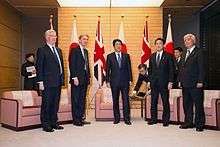
- 2011. UK sends over rescue men with rescue dogs and supplies to help the Japanese, after the 11 March 2011 Tōhoku earthquake and tsunami.
- 2012. A UK trade delegation to Japan, led by Prime Minister David Cameron, announces an agreement to jointly develop weapons systems.
- February 2015. Prince William, Duke of Cambridge on an official visit tours areas devastated by the 2011 Tsunami including Fukushima, Ishinomaki, and Onagawa.[22]
- September 2016. Citing concerns for Japanese owned business operating in the United Kingdom in the wake of the European Union membership referendum, the Japanese Ministry of Foreign Affairs directly issues a 15-page memorandum on its own website requesting that the British Government strike a Brexit agreement safeguarding UK’s current trading rights in the European Single Market.[23]
See also the chronology on the website of British Embassy, Tokyo.[24]
Britons in Japan
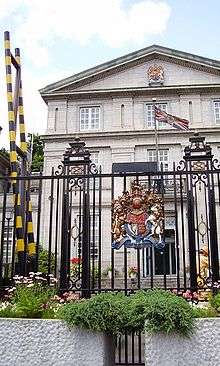
- William Adams (Miura Anjin)
- Rutherford Alcock, diplomat
- William George Aston, consular official and Japanologist
- William Edward Ayrton, Professor of physics & telegraphy
- Thomas Baty, legal adviser.
- Felice Beato – British/Italian/Corfiote photographer
- Edward Bickersteth, First Anglican Bishop of South Tokyo
- Isabella Bird – Victorian traveller and author
- John Reddie Black, publisher of newspapers
- Duncan Gordon Boyes – winner of the Victoria Cross at Shimonoseki, 1864
- Richard Henry Brunton, Father of Japanese lighthouses
- Basil Hall Chamberlain, Professor and Japanologist
- Edward Bramwell Clarke, Professor who helped introduce rugby to Japan
- Samuel Cocking – Yokohama merchant
- Josiah Conder, architect
- Hugh Cortazzi, scholar and former ambassador
- James Main Dixon (1856–1933). Former FRSE. After teaching at the Imperial University of Tokyo, he moved to the University of South California.
- Archibald Douglas, leader of a naval mission to Japan in the early 1870s
- Henry Dyer, first principal of the Imperial College of Engineering (Kobu Daigakko)
- Lord Elgin, signed the 1858 treaty
- James Alfred Ewing, Professor
- Hugh Fraser, British minister 1889–94
- Thomas Blake Glover, Scottish trader
- Abel Gower, consul
- William Gowland, 1842–1922, Father of Japanese archaeology
- Thomas Lomar Gray, engineering professor
- Arthur Hasketh Groom, creator of the first golf course in Japan
- John Harington Gubbins, diplomat
- Joseph Henry Longford, consul and academic
- Claude Maxwell MacDonald, diplomat
- Ranald MacDonald, the first English teacher in Japan
- John Milne, Professor and Father of Seismology
- Algernon Bertram Mitford (Lord Redesdale), diplomat
- James Murdoch – teacher, journalist, historian
- Edward St. John Neale, Lt.-Col, Secretary of Legation then Chargé d'Affaires 1862–1863
- Laurence Oliphant – Secretary of Legation in 1861
- Henry Spencer Palmer – engineer and Times correspondent
- Harry Smith Parkes, diplomat
- David Peace, novelist, whose most recent novel are set in post-World War II Japan.
- John Perry, colleague of Ayrton at the Imperial College of Engineering, Tokyo
- Charles Lennox Richardson – slain in the Namamugi Incident
- Ernest Mason Satow, diplomat and Japanologist
- Alexander Cameron Sim – founder of Kobe Regatta & Athletic Club, introduced lemonade (ramune) to Japan.
- Admiral Sir James Stirling – signed the 1854 treaty
- Walter Weston, Rev. who publicised the term "Japanese Alps"
- William Willis, Dr.
- Charles Wirgman, editor of Japan Punch
The chronological list of Heads of the United Kingdom Mission in Japan.
Japanese in the United Kingdom

(see article Japanese in the United Kingdom).
The family name is given in italics. Usually the family name comes first, but in modern times not so for the likes of Kazuo Ishiguro and Katsuhiko Oku, both well known in the United Kingdom.
- Aoki Shūzō – diplomat, signed the 1894 treaty in London
- Hayashi Tadasu
- Inagaki Manjirō, Cambridge University graduate and diplomat
- Kazuo Ishiguro
- Iwakura Tomomi – see Iwakura mission especially
- Kikuchi Dairoku, Cambridge University graduate and politician
- Mori Arinori
- Natsume Sōseki
- Yoshinori Muto, footballer for Newcastle United
- Shunsuke Nakamura, played for Scottish football club Celtic
- Shinji Kagawa, played for English football club Manchester United
- Shinji Okazaki, footballer for Leicester City
- Katsuhiko Oku – Oxford University rugby player, diplomat in Japanese embassy in London who died in Iraq, 2003. Posthumously promoted to ambassador. See also the Oku-Inoue fund for the children of Iraq.
- Kishichiro Okura, entrepreneur
- Hisashi Owada, Cambridge University graduate, father of Princess Masako
- Suematsu Kenchō, Cambridge University graduate and statesman
- Ginnosuke Tanaka, Cambridge University graduate, introduced rugby to Japan
- Tōgō Heihachirō – Spent time in the UK, one of Japan's greatest naval heroes, the "Nelson of the East"
- Yamao Yōzō
- Taka Hirose, Bassist of the band Feeder
- Naoko Mori, actress – famous for playing Toshiko Sato in Torchwood and Doctor Who
- Yūki Amami, actress - studied in England
- Genda Minoru - Naval attaché and planner of the Pearl Harbor strike; in 1940 he saw Spitfires and Bf-109s in combat over London during the Battle of Britain
Education
In Japan:
In the UK:
List of Japanese diplomatic envoys in the United Kingdom (partial list)
Ministers Plenipotentiaries
- Terashima Munenori 1872-1873
- Kagenori Ueno 1874-1879
- Mori Arinori 1880-1884
- Masataka Kawase 1884-1893
- Aoki Shūzō 1894
- Katō Takaaki 1895-1900
- Hayashi Tadasu 1900-1905
Ambassadors
- Hayashi Tadasu 1905-1906
- Komura Jutarō 1906-1908
- Katō Takaaki 2nd time, 1908–1912
- Katsunosuke Inoue 1913-1916
- Chinda Sutemi 1916-1920
- Gonsuke Hayashi 1920-1925
- Keishiro Matsui 1925-1928
- Matsudaira Tsuneo 1929-1935
- Shigeru Yoshida 1936-1938
- Mamoru Shigemitsu 1938-1941
- Shunichi Matsumoto 1952-1955
- Haruhiko Nishi 1955-1957
- Katsumi Ōno 1958-1964
- Morio Yukawa 1968-1972
- Haruki Mori 1972-?
- Masaki Orita 2001-2004
- Yoshiji Nogami 2004-2008
- Shin Ebihara 2008–2011
- Keiichi Hayashi 2011–2016
- Koji Tsuruoka 2016-present
List of ambassadors of the United Kingdom to Japan
See also
- List of ambassadors of the United Kingdom to Japan
- History of Japanese foreign relations
- Japanese entry into World War I
- British Japan Consular Service
- o-yatoi gaikokujin – foreign employees in Meiji era Japan
- Foreign cemeteries in Japan
- Japan Society of the UK
- French–Japanese relations
- Germany–Japan relations
- Japanese in the United Kingdom, British people of Japanese descent
- China–United Kingdom relations
- Iwakura mission
- gaikoku bugyō
- Chōshū Five
- Japanese students in the United Kingdom
- List of Westerners who visited Japan before 1868
Notes
- ↑ Stephen Turnbull, Fighting ships of the Far East (2), p 12, Osprey Publishing
- ↑ Notice at the Tower of London
- ↑ The Red Seal permit was re-discovered in 1985 by Professor Hayashi Nozomu, in the Bodleian Library. Massarella, Derek; Tytler Izumi K. (1990) "The Japonian Charters" Monumenta Nipponica, Vol. 45, No. 2, pp 189–205.
- ↑ Thierry Mormanne : "La prise de possession de l'île d'Urup par la flotte anglo-française en 1855", Revue Cipango, "Cahiers d'études japonaises", No 11 hiver 2004 pp. 209-236.
- ↑ Information about 1885–87 Japanese exhibition at Knightsbridge
- ↑ Phillips Payson O'Brien, The Anglo-Japanese Alliance, 1902-1922. (2004).
- ↑ Gowen, Robert (1971). "Great Britain and the Twenty-One Demands of 1915: Cooperation versus Effacement". The Journal of Modern History. University of Chicago. 43 (1): 76–106. ISSN 0022-2801.
- ↑ Gordon Lauren, Paul (1978). "Human Rights in History: Diplomacy and Racial Equality at the Paris Peace Conference". Diplomatic History. 2 (3): 257–278. doi:10.1111/j.1467-7709.1978.tb00435.x.
- ↑ H. P. Willmott (2009). The Last Century of Sea Power: From Port Arthur to Chanak, 1894-1922. Indiana U.P. p. 496.
- ↑ Paul W. Doerr (1998). British Foreign Policy, 1919-1939. p. 120.
- ↑ A.J.P. Taylor, English History: 1914-1945 (1965) pp 370-72.
- ↑ David Wen-wei Chang, "The Western Powers and Japan's Aggression in China: The League of Nations and" The Lytton Report"." American Journal of Chinese Studies (2003): 43-63. online
- ↑ Xiao Yiping, Guo Dehong, 中国抗日战争全史、Chapter 87: Japan 's Colonial Economic Plunder and Colonial Culture, 1993.
- ↑ Thomas S. Wilkins, "Anatomy of a Military Disaster: The Fall of" Fortress Singapore" 1942." Journal of Military History 73.1 (2009): 221-230.
- ↑ Protocole entre le Gouvernement du Japon et le Gouvernement de la République française, 1957. Ministry of Foreign Affairs, Japan.
- 1 2 "Ceremonies: State visits". Official web site of the British Monarchy. Archived from the original on 6 November 2008. Retrieved 2008-11-27.
- ↑ Mineko Iwasaki (2012). Geisha of Gion: The True Story of Japan's Foremost Geisha. p. 287.
- ↑ http://linguanews.com/php_en_news_read.php?section=s2&idx=2321
- ↑ The British-Japanese Parliamentary Group, About us, official site.
- ↑ Penguin Pocket On This Day. Penguin Reference Library. 2006. ISBN 0-14-102715-0.
- ↑ "UK: Akihito closes state visit". BBC News. 1998-05-29. Retrieved 2008-11-25.
- ↑ "HRH The Duke of Cambridge to visit Japan and China - Focus on cultural exchange and creative partnerships". http://www.princeofwales.gov.uk/. Retrieved 2 March 2015. External link in
|website=(help) - ↑ Parker, George (4 September 2016). "Japan calls for 'soft' Brexit — or companies could leave UK". Financial Times. Retrieved 5 September 2016.
- ↑ "Archived copy". Archived from the original on 27 September 2007. Retrieved 9 January 2016.
Further reading
- The History of Anglo-Japanese Relations, 1600-2000
- I. Nish, and Y. Kibata, eds. The History of Anglo-Japanese Relations, Vol. I: The Political-Diplomatic Dimension, 1600-1930 (2000)
- I. Nish, and Y. Kibata, eds. The History of Anglo-Japanese Relations, Vol. II: The Political-Diplomatic Dimension, 1931-2000 (2000)
- I. Gow and Y. Hirama, eds. The History of Anglo-Japanese Relations, 1600-2000: Volume III, The Military Dimension, 1800-2000 (2003).
- J. Hunter and S. Sugiyama, The History of Anglo-Japanese Relations, 1600-2000: Volume IV: Economic and Business Relations (2002)
- G. Daniels and C. Tsuzuki, eds. The History of Anglo-Japanese Relations 1600–2000: Volume V: Social and Cultural Perspectives (2014).
- Akagi, Roy Hidemichi. Japan's Foreign Relations 1542-1936: A Short History (1979) online 560pp
- Auslin, Michael R. Negotiating with Imperialism: The Unequal Treaties and the Culture of Japanese Diplomacy (Harvard UP, 2009).
- Beasley, W.G. Great Britain and the Opening of Japan, 1834-1858 (1951) online
- Beasley, W. G. Japan Encounters the Barbarian: Japanese Travelers in America and Europe (Yale UP, 1995).
- Best, Antony. Britain, Japan and Pearl Harbour: Avoiding War in East Asia, 1936-1941 (1995) excerpt and text search
- Buckley, R. Occupation Diplomacy: Britain, the United States and Japan 1945-1952 (1982)
- Checkland, Olive. Japan and Britain after 1859: Creating Cultural Bridges (2004) excerpt and text search; online
- Britain & Japan: Biographical Portraits edited by Hugh Cortazzi Global Oriental 2004, 8 vol (1996 to 2013)
- British Envoys in Japan 1859–1972, edited and compiled by Hugh Cortazzi, Global Oriental 2004, ISBN 1-901903-51-6
- Denney, John. Respect and Consideration: Britain in Japan 1853 - 1868 and beyond. Radiance Press (2011). ISBN 978-0-9568798-0-6
- Dobson, Hugo and Hook, Glenn D. Japan and in the Contemporary World (Sheffield Centre for Japanese Studies/Routledge Series) (2012) excerpt and text search; online
- McKay, Alexander. Scottish Samurai: Thomas Blake Glover, 1838-1911 (Canongate Books, 2012).
- Marder, Arthur J. Old Friends, New Enemies: The Royal Navy and the Imperial Japanese Navy, vol. 1: Strategic illusions, 1936-1941(1981); Old Friends, New Enemies: The Royal Navy and the Imperial Japanese Navy, vol. 2: The Pacific War, 1942-1945 (1990)
- Morley, James William, ed. Japan's foreign policy, 1868-1941: a research guide (Columbia UP, 1974), toward Britain, pp 184-235
- Nish, I. The Anglo-Japanese Alliance (2nd ed 1985)
- Nish, Ian. "Britain and Japan: Long-Range Images, 1900-52." Diplomacy & Statecraft (2004) 15#1 pp 149-161.
- Nish, I., ed. Anglo-Japanese Alienation, 1919-1952 (1982),
- Nish, Ian Hill. Britain & Japan: Biographical Portraits (5 vol 1997-2004).
- Sterry, Lorraine. Victorian Women Travellers in Meiji Japan (Brill, 2009).
- Thorne, Christopher G. Allies of a kind: The United States, Britain, and the war against Japan, 1941-1945 (1978) excerpt and text search
- Thorne, Christopher G. The Limits of Foreign Policy: The West, The League and the Far Eastern Crisis of 1931-1933 (1973)
- Towle, Phillip and Nobuko Margaret Kosuge. Britain and Japan in the Twentieth Century: One Hundred Years of Trade and Prejudice (2007) excerpt and text search
- Woodward, Llewellyn. British Foreign Policy in the Second World War (History of the Second World War) (1962) ch 8
External links
- A Bibliography of Anglo-Japanese relations – at Cambridge University
- The Asiatic Society of Japan – in Tokyo
- The British Association for Japanese Studies
- The British Consulate – in Nagoya
- The British Consulate-General – in Osaka
- The British Council in Japan – the cultural arm of the British government overseas
- The British Chamber of Commerce in Japan
- The British Embassy – in Tokyo
- The British Trade Promotion Office in Fukuoka (closed June 2005)
- The Cambridge & Oxford Society – founded in Tokyo in 1905
- The Daiwa Anglo-Japanese Foundation – in London and Tokyo
- The Embassy of Japan – in London
- The Great Britain Sasakawa foundation – in London and Tokyo
- The Japan Society – founded in London in 1891
- The Japan-British Society – founded in Japan in 1908
- Japan-U.K. Relations at Japan's Ministry of Foreign Affairs Official Website.
- JETAA UK Japan Exchange and Teaching Programme Alumni Association United Kingdom


